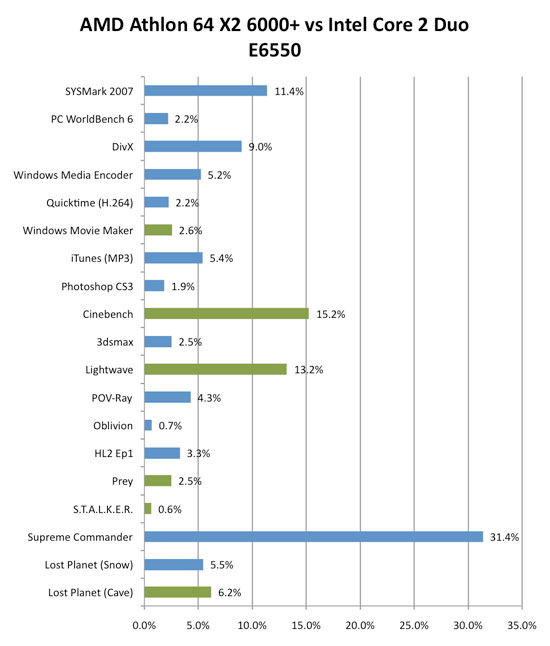Intel Core 2 Extreme QX9650 - Penryn Ticks Ahead
by Anand Lal Shimpi on October 29, 2007 12:13 AM EST- Posted in
- CPUs
Another Price Drop? A Competitive Update
Although this couldn't be further from the matter at hand, AMD has quietly dropped its prices since the last time we looked at upper mainstream performance. The new/old AMD pricing structure is as follows:
| CPU | Old Price | New Price |
| AMD Athlon 64 FX-74 | $599/pair | $599/pair |
| AMD Athlon 64 X2 6000+ | $178 | $167 |
| AMD Athlon 64 X2 5600+ | $157 | $146 |
| AMD Athlon 64 X2 5200+ | $136 | $125 |
| AMD Athlon 64 X2 5000+ | $125 | $115 |
| AMD Athlon 64 X2 4800+ | $115 | $104 |
| AMD Athlon 64 X2 4400+ | $94 | $89 |
| AMD Athlon 64 X2 4000+ | $73 | $68 |
| AMD X2 BE-2350 | $91 | $96 |
| AMD X2 BE-2300 | $73 | $91 |
The price changes are fairly minor, but they do change the way we have to compare these processors. For example, the Athlon 64 X2 6000+ used to be priced close to the Core 2 Duo E6750, but now it's an E6550 competitor, improving AMD's competitive stance. For some reason, AMD's 45W Athlon X2 processors actually went up in price, possibly due to fluctuation in yields.
The other major change is that below the 6000+, all of AMD's chips compete with Intel's E4000/E2000 series, not the E6000 line. We'll be working on an update to our Midrange CPU Roundup to take some of these changes into account, but for this review we'll do a quick update looking at the 6000+ compared to its new price competitor, the E6550.
The chart below shows the percent difference in scores between the 6000+ and the E6550; the blue bars mean that Intel won that test and the green bars indicate that AMD won:

AMD definitely gets more competitive with its price drop, but Intel still holds on to the competitive advantage. Not only is the E6550 faster overall, it is also a cooler running processor (keeping in mind that the 6000+ is still a 90nm core) with more overclocking headroom.










16 Comments
View All Comments
Canadian87 - Monday, October 29, 2007 - link
I'd like to point out that someone must have been tired when writing this. The graphs here on page 4 say "QX6950" VS "QX6850", simple reversal of the numbers, but I'd like to correct it for those that might be confused, took me a moment to figure out which was which myself the "QX6950" is ment to be the "QX9650", and obviously the "QX6850" is the correct naming.GL HF.
GlassHouse69 - Monday, October 29, 2007 - link
ew.intel again ftw. blech. They made a great chip. power usage is fantastic. One could get even lower total wattages (by far) if they concentrated on doing so. a quad core that can be cooled near silently. neat :)
sprockkets - Monday, October 29, 2007 - link
Just a question, what was the difference from Core to Core 2? All I could ever fine was cache size was increased.Now that I'm thinking about it, why not the name Quadro? Oh, nVidia ownz it.
defter - Monday, October 29, 2007 - link
Core Duo (Yonah) was based on Pentium M.Core2 (Conroe) is a new architecture.
sprockkets - Monday, October 29, 2007 - link
actually i found a comparison page about it, and core 2 isn't that much different from core. Yes, it updated a lot and gave improved performance. No, it is not a completely new architecture from PM, but you can say a big difference from the P4.http://www.anandtech.com/showdoc.aspx?i=2808&p...">http://www.anandtech.com/showdoc.aspx?i=2808&p...
sprockkets - Monday, October 29, 2007 - link
On page 9 I believe you are grabbing some old benchmarks, old in the sense of your previous articles. I believe I pointed this out to you as a mistake, and now it is here in the bar graph. Again, how is it that the 2.33ghz C2D outperforms the 3ghz one?